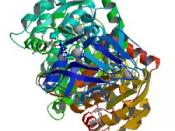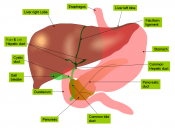Americans love libations and mind-altering substances and the loquacious and amiable effects the abuse of which has on them. In order to survive these "high times" human livers must process the dangerous chemicals in drugs and alcohol. The health of a person, especially that person's liver, strongly correlates to the amount drugs or alcohol that person consumes. Alcohol, specifically, is one of the most dangerous substances to expose the liver to.
In the liver the alcohol dehydrogenase enzyme, produced by the smooth ER, breaks down alcohol by removing hydrogen in two steps. First alcohol dehydrogenase oxidizes alcohol to acetaldehyde. Then acetaldehyde dehydrogenase oxidizes the acetaldeyde to cetyl CoA. These reactions produce hydrogen ions and the B vitamin niacin and in it's role as the coenzyme NAD, picks up these hydrogen ions thereby becoming NADH. Thus when alcohol is metabolized, NAD diminishes and NADH increases. Enzymes catalyze the addition of hydroxyl groups to drugs and poisons, thereby making them soluble in the cytosol so they may be excreted.
Ninety to ninety-eight percent of the ingested drug or alcohol is completely oxidized and the small amounts that remain are excreted unchanged in the breath, urine and sweat. Smooth ER in liver cells proliferates in response to barbiturates, alcohol and other drugs; therefore, in turn, the use of drug or alcohol may increase drug and alcohol tolerance.
Due to this process, NAD becomes unavailable for the many other vital body processes for which it is needed, including glycolysis, the TCA cycle and the electron transport chain. Without NAD, the energy pathway is blocked, and alternative routes are taken, with serious physical consequences such as the accrual of hydrogen atoms causing the shift the body's balance toward acid. Also the accrual of NADH slows the TCA cycle, resulting in a build up of...


